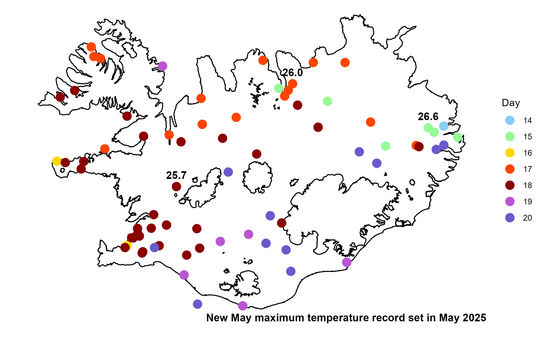The most significant May heatwave ever recorded in Iceland
- Temperatures
reached or exceeded 20°C at several weather stations for 10 consecutive
days.
- May temperature records were repeatedly broken at weather stations across the country.
- A new
national May temperature record of 26.6°C was set at Egilsstaðir Airport
on May 15th.
From May 13 to 22, 2025, an unusual heatwave occurred in Iceland. The weather situation leading to it was a persistent high-pressure system near the Faroe Islands, which gradually moved over Iceland. This high-pressure system directed warm air from the south and southeast toward the country for several days. Although similar weather conditions have occurred before, this heatwave was exceptional due to how early in the year it happened, how long it lasted, and how widespread it was.
The entire
country experienced very warm and bright weather during these days, with
temperatures far above the seasonal average. The temperature anomalies were
highest in the northeastern and eastern highlands of Iceland, where the average temperature anomaly exceeded 10°C
(see Figure 1). It wasn't quite as warm along the southern and southeastern
coasts, but even there, the temperature anomalies were about 3°C or higher.
Figure
1: Temperature anomalies (°C) at automatic weather stations from May 13 to 22,
2025. Anomalies are calculated with respect to the expected daily temperatures
calculated from the past ten years (2015 to 2024).
During cold May months in Iceland temperatures may never exceed 20°C. While this is not uncommon, in recent years May temperatures have reached 20 °C somewhere in Iceland for 2-3 days on average. During this heatwave temperatures reached 20°C or more somewhere in the country for 10 consecutive days (May 13–22), as well as on May 7, bringing the total number of plus-20° days in May 2025 so far to 11 (see Figure 2).
Temperatures peaked over the weekend of May 17–18. On those days, temperatures reached 20°C or more at about half of all weather stations in Iceland (see Figure 2). The national average temperature also peaked during those two days (see Figure 3).
The first three weeks of May 2025 were exceptionally warm. When comparing the national daily average temperature to the 10-year average expected daily temperatures, only two days in May had slightly below-average temperatures, while all other days were above average (see Figure 3).
At many weather stations across the country, the average temperature for the first 22 days of May has never been this high. This includes decades old stations such as Stykkishólmur (reliable daily maximum temperature data since 1846), Reykjavík (since 1881), Dalatangi (since 1939), and Vatnsskarðshólar (since 1951). In the town of Akureyri which has more than 100 years of temperature measurements the average for the first 22 days of May 2025 is 10.9°C - by far the warmest on record for this period. The same applies to the hightland station at Grímsstaðir á Fjöllum, where the average temperature for the first 22 days of May was just under 10°C, the highest recorded in 119 years of continuous measurements.
Figure
2: The bar chart shows the percentage of weather stations that recorded
temperatures of 20°C or higher from May 1 to 22, 2025. On May 17 and 18, about
50% of all stations recorded such temperatures. Red dots and a line indicate
the national maximum temperature on each of those days. The highest temperature
was 26.6°C at Egilsstaðir Airport on May 15, setting a new national
May temperature record.
Figure 3: National daily average temperature from May 1 to 22, 2025, compared to the past ten years (2015 to 2024). Overall, these Maydays were exceptionally warm. Only May 9 and 10 were slightly below average.
Numerous May Records Broken
Furthermore, new May temperature records were set at 94% of all automatic stations that have been operated for at least 20 years. The highest temperature was 26.6°C at Egilsstaðir Airport on May 15, setting a new national May temperature record. The previous record was 25.6°C in Vopnafjörður and occurred on May 26, 1992.
The old record from 1992 was surpassed three more times in the following days in different parts of the country:
- Egilsstaðir Airport again (26.4° on May 17),
- Végeirsstaðir in Fnjóskadalur (26.0°C on May 17),
- Húsafell (25.7°C on May 18).
Figure 4 shows all automatic weather stations where a new May maximum temperature record was set. Only stations with at least 20 years of data were considered and from the 88 such stations, new May temperature records were set at 83 of them (94% of the stations). Most of these records were set on May 17 and 18, although the timing of peak temperatures varied slightly by region.
Manned weather stations generally have been in operations for a much longer period than the automatic stations. Among these, the highest May temperatures ever recorded occurred at:
- Stykkishólmur: 20.5°C (17 May, 174 years of data)
- Grímsstaðir á Fjöllum: 24.0°C (15 May, 119 years of data)
- Litla-Ávík: 23.3°C (17. May, 31 year of data)
The second-highest May temperatures ever recorded occurred in Reykjavík [Now 20,3°C; earlier record : 14 May 1960, 20.6°C) and Akureyri. (Now: 17 May 24.2°C; earlier record: 22 May 1980 24.6°C)
Figure 4: Location of stations with new temperature records. Automatic weather stations where new May maximum temperature records were set during the May 2025 heatwave. Only stations with at least 20 years of data are included. The color of each dot indicates the day on which the new record was set.
Historical Heatwaves
Heatwaves occasionally occur in Iceland, that is intervals were temperatures are significantly above normal for several consecutive days. The current heatwave (May 13–22, 2025) is the most intense ever recorded in Iceland during May. The closest comparable May heatwave occurred in 1987, under very similar weather conditions.
The most significant heatwaves in recent years, in terms of duration and extent, occurred around the end of July and beginning of August 2008, and in August 2004. Then, like now, many temperature records were broken across the country, and temperatures exceeded 20°C for several days in a row. However, those heatwaves reached even higher temperatures, as they occurred in late summer rather than spring.
Temperatures during the summer of 2021 were also unusually high, although that event was mostly confined to the Northeast and East of Iceland. Other notable heatwaves also occurred in July 1976 and 1991. A major heatwave also struck in June 1939, when the temperature at Teigarhorn reached 30.5°C on June 22—the highest temperature ever recorded in Iceland.








